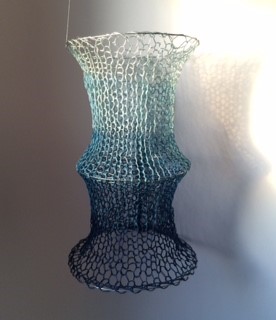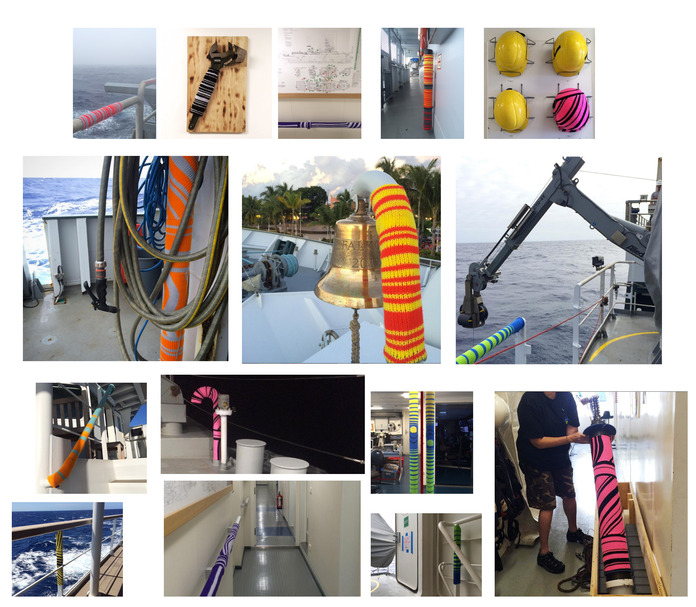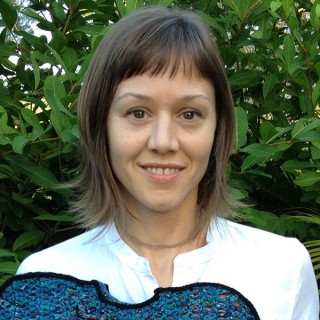
Today I present another look at my art process aboard the Falkor. This unique residency presented a fantastic opportunity to focus and also brought unexpected challenges. Overall it has been an excellent learning experience.
From macrobiology to microbiology and chemistry

Before this voyage, most my collaborations with marine scientists have been with biologists studying relatively large creatures in the ocean. This crew’s approach emphasizes microbiology and chemistry at both a small and broad scale, so it took time for me to adjust to the methods and scope of their work.
Each time the ship stopped at a predetermined location for sampling, the crew got better at deploying and retrieving their equipment while I comprehended more of the mission. As I observed real-time information relayed from the CTD (a device for measuring attributes including conductivity, temperature, and depth) I was inspired by the layers of information being received simultaneously. I was also compelled to highlight these moments of the voyage which formed the basis for the sampling done by everyone in the science crew. I decided to feature this process in my series of textiles.
CTD casts as textile representations
This series, still a work in progress, consists of a swatch of fabric for each sampling station on our voyage. Each panel has a different appearance, reflecting the variation in conditions experienced at each location. The lines and colors may appear to be abstract, but their arrangements are deliberate and reflect the conditions in these specific areas of the ocean.
Using undyed wool yarn and indigo-dyed silk threads, I knit a series of square panels. Each can be viewed as a section of the water column with the air/water surface at the top and the deepest measurement at the bottom. One lofty strand of wool and two thin strands of silk were held together to make each stitch. The shades of silk change as the square is built: I used two strands of the darkest blue for a few rows, then swapped one strand for the next lighter shade at a regular rate until I finished with the lightest blue and silver threads for the uppermost rows. The gradient of silver and blues show the presence of light at the surface and its extension through the water. The neon lines are nylon cord, a non-traditional yarn I have crocheted into surface designs tracing the levels of fluorescence (green), oxygen (yellow) and light (orange) in the water.
Once knitted up, the pale wool reminds me of a blanket of snow or “marine snow” a catch-all term for materials drifting down through the water column. The wool was slightly fulled from the combination of water, temperature, friction and soap I applied to the swatches. This treatment brought the stitches into a tighter arrangement.
Going forward with fiber
As the samples obtained during our voyage are scrutinized by our science crew, more will be understood about the ocean and the layers of systems interacting on our planet. I too will keep working with these measurements and materials for years, completing the CTD series and building upon the waves of ideas generated during this transit.
This experience as an Artist-at-Sea has affirmed my personal mission to stay curious, be inspired by nature, and keep developing more ways to weave elements of science into art. Because this seagoing adventure aboard the Falkor began in Honolulu Harbor, only a few miles from my home, I was given a unique perspective of the Hawaiian archipelago and Polynesia, something vastly different than an airplane ride could convey. Mahalo nui loa to the Schmidt Ocean Institute for this outstanding residency program!
Above are examples of Schwengel-Regala’s Dazzle camouflage. From Left to Right, Top to Bottom:
Jan 30 – Red & gray binary code stripes “FALKOR” on upper aft deck rail
Jan 21 – Gray & black binary code “FALKOR” on InMartech InMargyver Award
Feb 5 – Purple & grey on hallway railing with ship map
Feb 5 – Yellow, orange, red, gray, & black binary code “FALKOR FIRE PLAN” on starboard fire plan tube
Jan 29 – Pink & black stripes on science crew helmet
Row 2:
Feb 2 – Dazzle camoulage on aft deck
Feb 8 – Personalized Yarn bomb on Ship’s bell
Feb 1 – Green and blue dazzle camoulage near CTD deployment
Row 3:
Jan 17 – Orange & aqua stripes on starboard railing approaching bridge
Feb 2 – Black and Pink dazzle at night
Jan 25 – Split image of SOI yarnbomb on pole in Dry Lab near Science Control Room
Feb 3 – ARGO float with knitted sweater
Row 4:
Jan 23 – yellow & black on starboard railing
Feb 5 – Purple & grey on hallway railing with ship map
Jan 24 – green & blue on stairway railing

